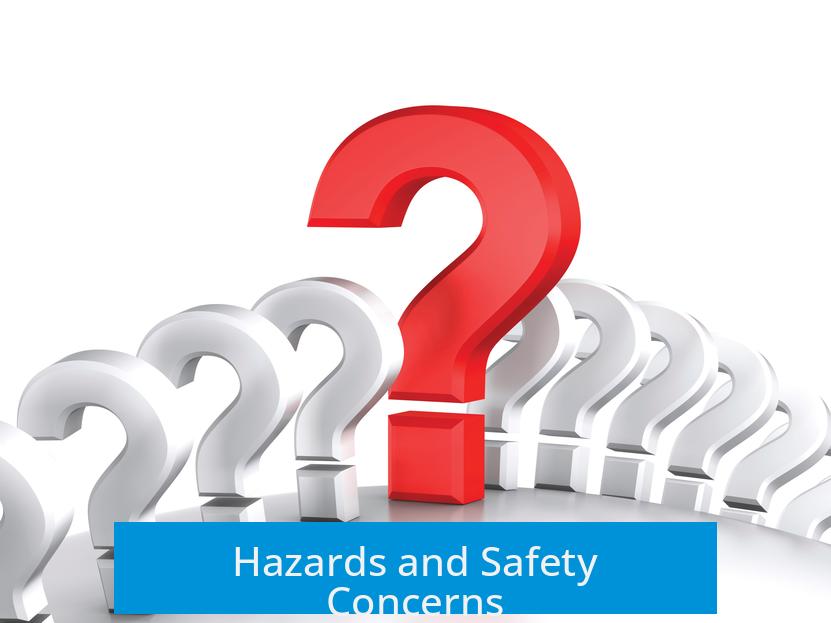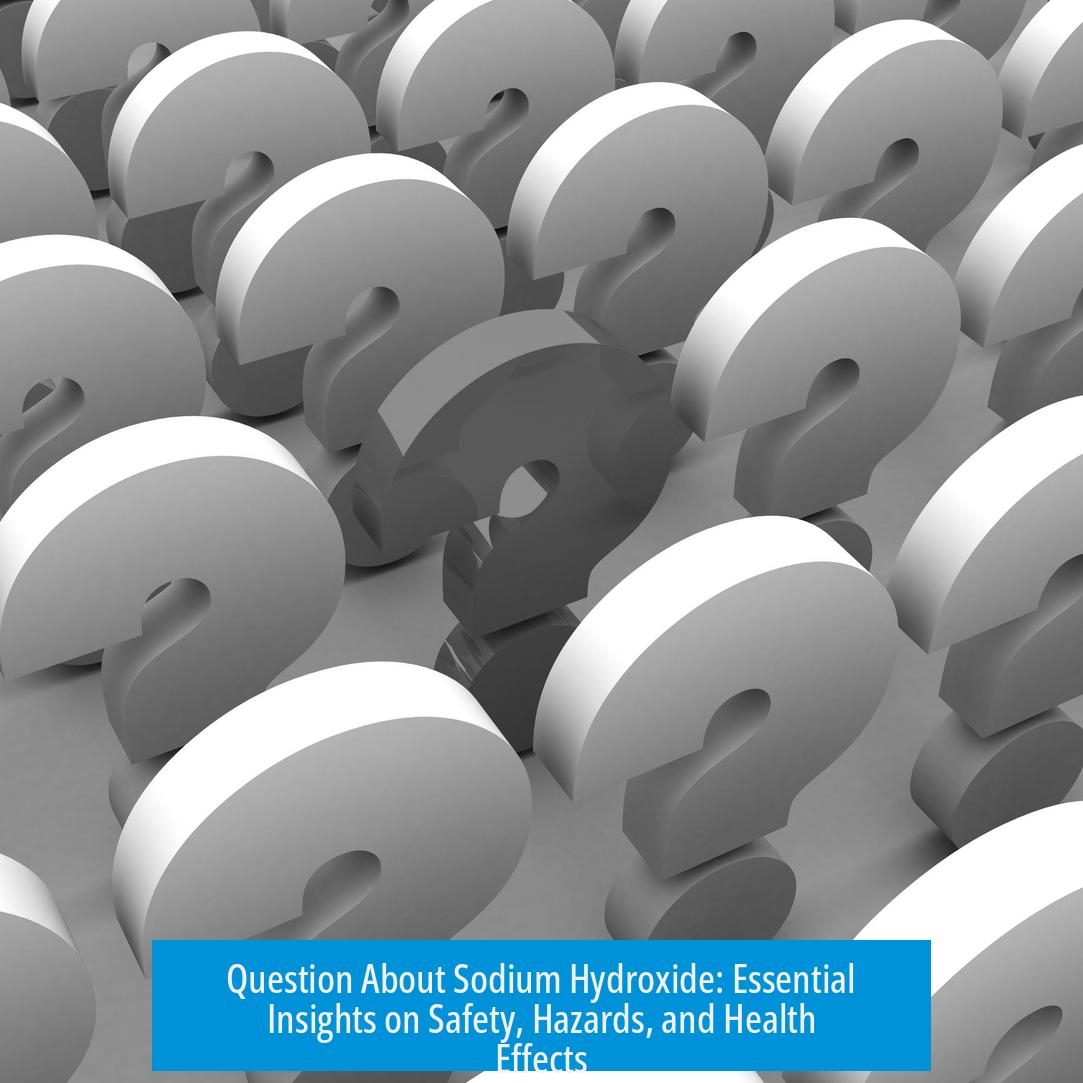Understanding Sodium Hydroxide: Forms, Hazards, and Safety

Sodium hydroxide is commonly available in two primary forms: concentrated and non-concentrated aqueous solutions. These aqueous forms differ mainly in the concentration of NaOH dissolved in water but are otherwise similar in handling and hazards. Solid sodium hydroxide, often referred to as pellets or flakes, represents another form with specific handling considerations.
Forms of Sodium Hydroxide
- Aqueous Solutions: Sodium hydroxide is widely used in solution form, varying from dilute (non-concentrated) to concentrated solutions depending on application needs.
- Solid Pellets: Sold as white flakes or pellets, solid NaOH is highly caustic and tends to absorb moisture from air.
The two forms present different challenges and risks. Solutions are easier and generally safer to handle than solids, which require more care during dissolution.
Hazards and Safety Concerns

Inhalation Risks
Sodium hydroxide is non-volatile. As a result, aqueous NaOH solutions pose no inhalation risk. They do not emit vapors that could cause respiratory problems.
However, when working with solid NaOH pellets, caution is necessary. Dissolving pellets in water generates heat and can produce a fine mist or aerosol.
- This mist warrants adequate ventilation.
- Wearing a mask is recommended to avoid inhalation of aerosolized particles.
For everyday use, such as handling solutions, inhalation hazards are minimal and not a concern for individuals with asthma.
Skin Contact and Damage

Sodium hydroxide is a strong caustic agent. Contact with skin causes damage that is not always immediately obvious.
- The characteristic slippery or soapy sensation on skin occurs because NaOH breaks down proteins, similar to acid burns.
- Despite this slippery feeling, the damage progresses if not promptly washed off with large volumes of water.
- Delays in washing may lead to increasingly painful and severe chemical burns.
Immediate access to washing facilities is critical when working with NaOH to remove any accidental contact promptly.
Eye Protection
Eye exposure to sodium hydroxide is a severe hazard. Even small splashes can cause permanent damage to the eyes.
Proper eye protection, such as fitted chemical safety goggles, is essential at all times during handling to prevent accidental splashes from reaching the eyes.
Handling Advice for Different Forms

| Form | Risks | Safety Measures |
|---|---|---|
| Solid Pellets |
|
|
| Aqueous Solutions |
|
|
Impact on Asthma and Respiratory Health
Concerns about asthma and respiratory effects arise predominantly with inhalable chemicals.
Sodium hydroxide, especially in solution form, does not evaporate or form vapors harmful to respiratory systems. Therefore, it has no impact on asthma or similar conditions in typical laboratory or household concentrations.
Even during handling of solid pellets, the inhalation risk involves physical irritation from mist, not chemical toxicity affecting asthma. Appropriate ventilation and protective equipment mitigate this.
Key Takeaways
- Sodium hydroxide exists as aqueous solutions and solid pellets, each with distinct handling protocols.
- Aqueous solutions are not volatile; inhalation hazards are negligible.
- Solid pellets require careful handling due to heat and mist generation during dissolution.
- Skin contact risks include delayed but serious chemical burns, marked by a slippery sensation.
- Full eye protection is essential to prevent permanent damage.
- Aqueous sodium hydroxide has no effect on asthma sufferers.
- Immediate washing with water after contact reduces severity of skin and eye injuries.
Question About Sodium Hydroxide: What You Really Need to Know
So, what’s the deal with sodium hydroxide? This chemical has a reputation—some call it caustic, others simply say it’s a strong base. Let’s cut through the jargon: sodium hydroxide (NaOH) is available mostly in two forms. You either find it as solid pellets or dissolved in water as an aqueous solution. Both forms have their perks and quirks, but knowing how to handle them safely is key.
Imagine this. You’re prepping some lab work, and you see a big container labeled “Sodium Hydroxide.” You wonder, “Is it dangerous? What should I watch out for?” Well, we’re diving deep into forms, hazards, and practical advice so you don’t end up with a nasty burn or melted eye protection.
Forms of Sodium Hydroxide: Pellets vs. Solutions
Sodium hydroxide shows up in two common forms: solid pellets and aqueous solutions. The pellets look like small white balls, while aqueous forms are just NaOH dissolved in water. Your guess about concentrated versus non-concentrated is spot on; those terms usually describe aqueous solutions. The concentration can vary widely—from a mild cleaning mixture to highly caustic solutions used in manufacturing.
Handling it as a solution is generally safer. It doesn’t evaporate or release harmful vapors, which means no inhalation risks. Pellets, on the other hand, deserve respect. Dissolve them in water, and they generate intense heat—like nature’s mini fireworks but less fun and more dangerous.
Hazards and Safety Concerns: Let’s Get Serious Without Panic
First up: inhalation hazard. Sodium hydroxide is not volatile. This means it won’t turn into a gas and sneak into your lungs if you’re using aqueous solutions. So, if you’re working with liquid sodium hydroxide, inhale deeply without fear of lung drama.
But if you’re dealing with solid pellets, the story changes a bit. When you dissolve pellets in water, they can create mist. Breathing mist calls for good ventilation and possibly a mask. It’s the pellets’ way of saying “Hey, don’t breathe me in directly!” So, keep your windows open or wear some sort of protection.
Plus, there’s the heat spike. Dissolving pellets produces heat enough to cause burns or boil water suddenly. Always add pellets slowly and stir carefully. Safety goggles and gloves aren’t just fashion statements here—they’re lifesavers.
Skin Contact: The Slippery Slope
Got sodium hydroxide on your skin? Don’t panic, but don’t ignore it either. NaOH burns don’t scream immediately—they sneak up like a villain in a drama. Your skin might feel slippery or “soapy,” but that sensation actually means the hydroxide ions are breaking down proteins. Yes, it’s essentially causing chemical burns by dissolving the proteins on your skin.
The rule? If your skin feels slippery, wash it off with plenty of water—fast. Immediate and thorough rinsing is your best defense. Delaying is like leaving a cut open to infection: it gets worse.
Always keep a wash station nearby if you regularly handle sodium hydroxide. Trust me, having running water within arm’s reach isn’t just convenient—it can prevent serious injuries.
Eye Protection: Non-Negotiable Gear
Here’s a no-nonsense fact: a splash in the eye can cause severe and permanent damage. Sodium hydroxide doesn’t mess around with those sensitive tissues. A quick rinse might save you from blindness, but prevention is smarter.
Wear goggles that seal well around your eyes every time you work with NaOH, whether pellets or solution. Nothing else compares to this essential protective gear. No exceptions—even if you think you’re just “dabbling” with a small amount.
Handling Advice: Pellets or Solutions?
While pellets are trickier to handle—heat generation, mist formation, and skin hazards—the aqueous forms are no slackers. Solutions might not feel threatening, but they can still cause burns if spilled or splashed.
In fact, some seasoned users admit feeling the slippery solution and assuming it’s harmless soap. It’s not. Chemicals that feel slippery and smooth can be quite dangerous. The key takeaway: always treat sodium hydroxide with respect, keep protective gear on, and have immediate access to water to wash off any contact.
Effects on Asthma: Clearing the Air
If you’re worried about asthma, sodium hydroxide in its liquid form should not give you trouble. It has no impact on asthma, unlike some allergens or irritants. The solid pellets need care to avoid mist inhalation, but solutions won’t aggravate your lungs.
So, no need to avoid NaOH solutions if you have asthma. Just don your gear and keep exposure limited. Remember, it’s the direct contact and mismanagement that cause problems, not a sneaky asthma trigger.
Final Thoughts: Sodium Hydroxide in Real Life
Regular folks may mostly encounter sodium hydroxide in household drain cleaners, where it dissolves clogs like a champ. Industrial uses cover soap making, textiles, paper, and chemical synthesis. Understanding the basic forms and handling requirements makes a huge difference in safety.
What’s the surprising part? Sodium hydroxide feels soapy on your skin, so it’s easy to mistake for a benign substance. But this “slippery villain” demands caution. Have you ever heard stories of burns from NaOH that seemed minor at first but worsened later? That’s the delayed effect nobody talks about at parties.
Next time you see a chemical labeled sodium hydroxide, you’ll know the score. You respect the solid pellets, handle solutions carefully, and protect your eyes like a pro.
Now, let me ask you: Have you ever handled sodium hydroxide? What was your experience with the pellets versus the solution? Drop your thoughts below, because understanding real stories helps everyone stay safer.
Is sodium hydroxide in aqueous solution an inhalation hazard?
No, sodium hydroxide in water is not volatile and does not pose an inhalation hazard. However, pellets can create mist when handled, so use ventilation and a mask.
Why does sodium hydroxide feel slippery on the skin?
The slippery sensation comes from sodium hydroxide damaging skin proteins, similar to acid burns. Wash immediately with water if this happens to avoid burns.
What should I do if sodium hydroxide gets on my skin?
Rinse the affected area with plenty of water right away. Quick washing prevents burns, which may not appear immediately after contact.
Are sodium hydroxide pellets more dangerous than aqueous solutions?
Yes, pellets can get hot when dissolved and may form mist, requiring more safety precautions like masks and ventilation compared to solutions.
Does sodium hydroxide affect asthma?
Handling sodium hydroxide solutions does not impact asthma. It is safe for people with asthma when used properly in aqueous form.
Is eye protection necessary when working with sodium hydroxide?
Yes, always wear full eye protection like goggles. A splash can cause severe and permanent eye damage.





Leave a Comment